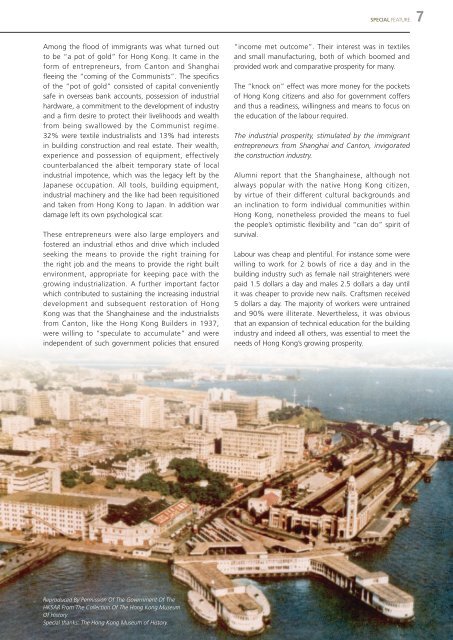Issue No. 4 (August 2007) - The Hong Kong Polytechnic University
Issue No. 4 (August 2007) - The Hong Kong Polytechnic University
Issue No. 4 (August 2007) - The Hong Kong Polytechnic University
Create successful ePaper yourself
Turn your PDF publications into a flip-book with our unique Google optimized e-Paper software.
SPECIAL FEATURE<br />
<br />
Among the flood of immigrants was what turned out<br />
to be “a pot of gold” for <strong>Hong</strong> <strong>Kong</strong>. It came in the<br />
form of entrepreneurs, from Canton and Shanghai<br />
fleeing the “coming of the Communists”. <strong>The</strong> specifics<br />
of the “pot of gold” consisted of capital conveniently<br />
safe in overseas bank accounts, possession of industrial<br />
hardware, a commitment to the development of industry<br />
and a firm desire to protect their livelihoods and wealth<br />
from being swallowed by the Communist regime.<br />
32% were textile industrialists and 13% had interests<br />
in building construction and real estate. <strong>The</strong>ir wealth,<br />
experience and possession of equipment, effectively<br />
counterbalanced the albeit temporary state of local<br />
industrial impotence, which was the legacy left by the<br />
Japanese occupation. All tools, building equipment,<br />
industrial machinery and the like had been requisitioned<br />
and taken from <strong>Hong</strong> <strong>Kong</strong> to Japan. In addition war<br />
damage left its own psychological scar.<br />
<strong>The</strong>se entrepreneurs were also large employers and<br />
fostered an industrial ethos and drive which included<br />
seeking the means to provide the right training for<br />
the right job and the means to provide the right built<br />
environment, appropriate for keeping pace with the<br />
growing industrialization. A further important factor<br />
which contributed to sustaining the increasing industrial<br />
development and subsequent restoration of <strong>Hong</strong><br />
<strong>Kong</strong> was that the Shanghainese and the industrialists<br />
from Canton, like the <strong>Hong</strong> <strong>Kong</strong> Builders in 1937,<br />
were willing to “speculate to accumulate” and were<br />
independent of such government policies that ensured<br />
“income met outcome”. <strong>The</strong>ir interest was in textiles<br />
and small manufacturing, both of which boomed and<br />
provided work and comparative prosperity for many.<br />
<strong>The</strong> “knock on” effect was more money for the pockets<br />
of <strong>Hong</strong> <strong>Kong</strong> citizens and also for government coffers<br />
and thus a readiness, willingness and means to focus on<br />
the education of the labour required.<br />
<strong>The</strong> industrial prosperity, stimulated by the immigrant<br />
entrepreneurs from Shanghai and Canton, invigorated<br />
the construction industry.<br />
Alumni report that the Shanghainese, although not<br />
always popular with the native <strong>Hong</strong> <strong>Kong</strong> citizen,<br />
by virtue of their different cultural backgrounds and<br />
an inclination to form individual communities within<br />
<strong>Hong</strong> <strong>Kong</strong>, nonetheless provided the means to fuel<br />
the people’s optimistic flexibility and “can do” spirit of<br />
survival.<br />
Labour was cheap and plentiful. For instance some were<br />
willing to work for 2 bowls of rice a day and in the<br />
building industry such as female nail straighteners were<br />
paid 1.5 dollars a day and males 2.5 dollars a day until<br />
it was cheaper to provide new nails. Craftsmen received<br />
5 dollars a day. <strong>The</strong> majority of workers were untrained<br />
and 90% were illiterate. Nevertheless, it was obvious<br />
that an expansion of technical education for the building<br />
industry and indeed all others, was essential to meet the<br />
needs of <strong>Hong</strong> <strong>Kong</strong>’s growing prosperity.<br />
New premises of <strong>Hong</strong> <strong>Kong</strong><br />
Technical College opened in<br />
Hung Hom in 1957<br />
Reproduced By Permission Of <strong>The</strong> Government Of <strong>The</strong><br />
HKSAR From <strong>The</strong> Collection Of <strong>The</strong> <strong>Hong</strong> <strong>Kong</strong> Museum<br />
Of History<br />
Special thanks: <strong>The</strong> <strong>Hong</strong> <strong>Kong</strong> Museum of History.
















